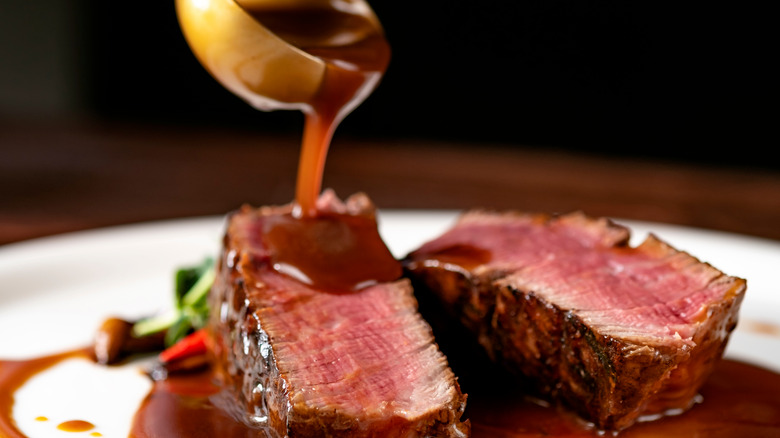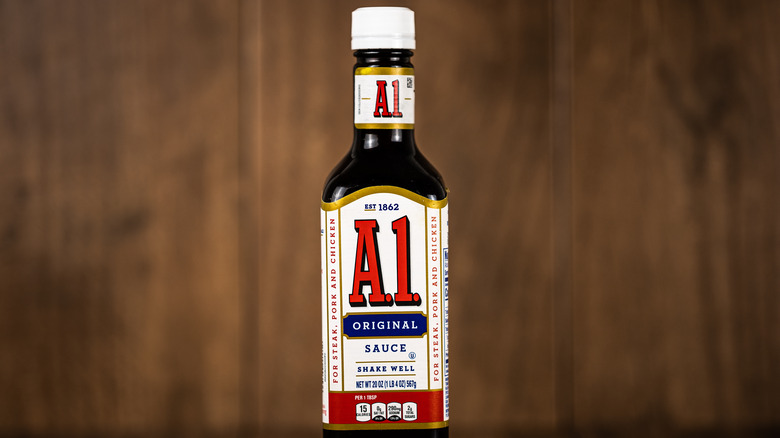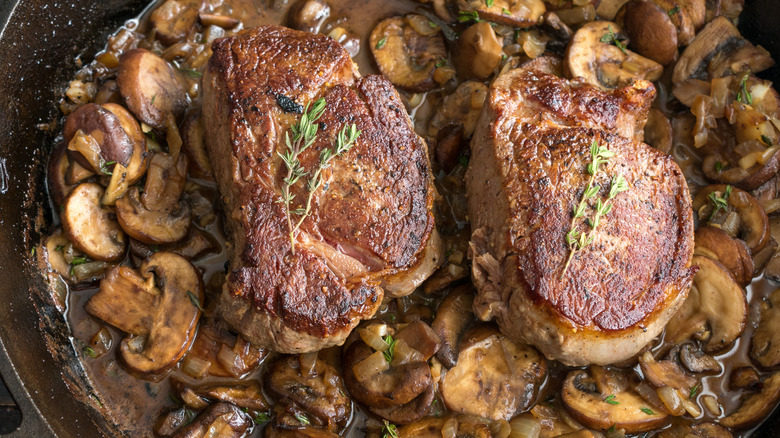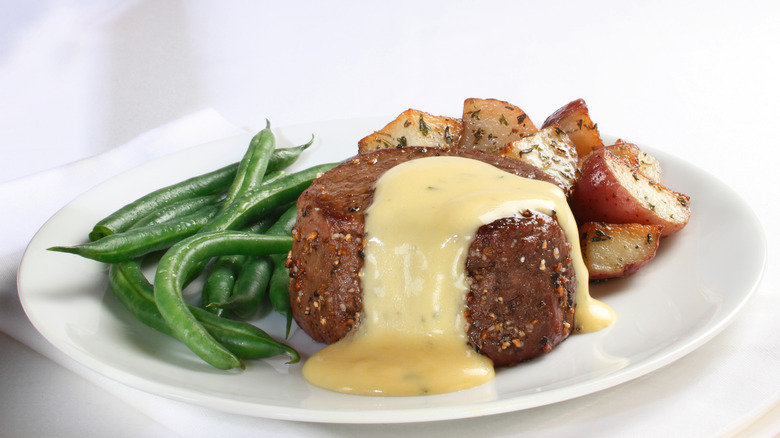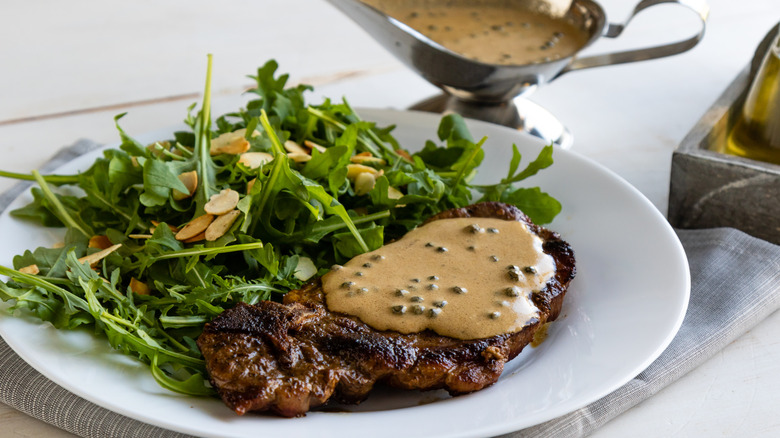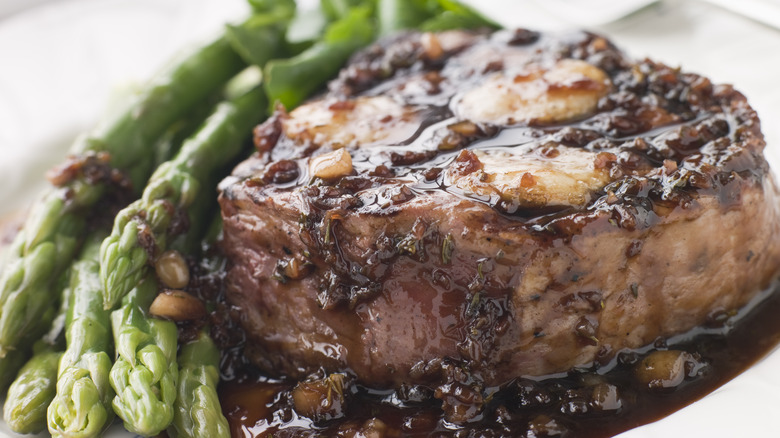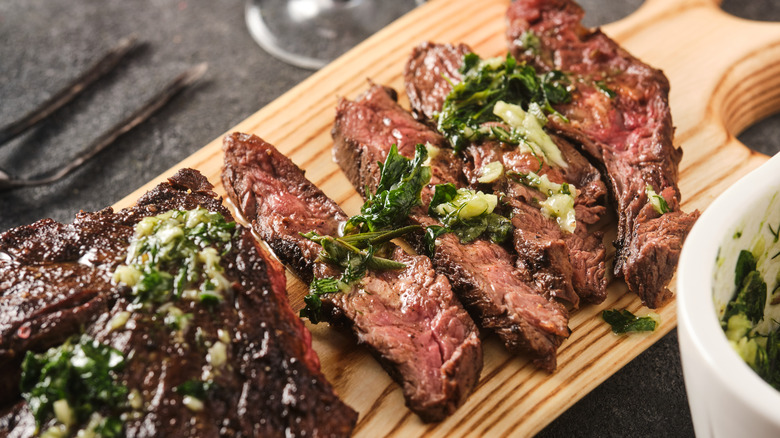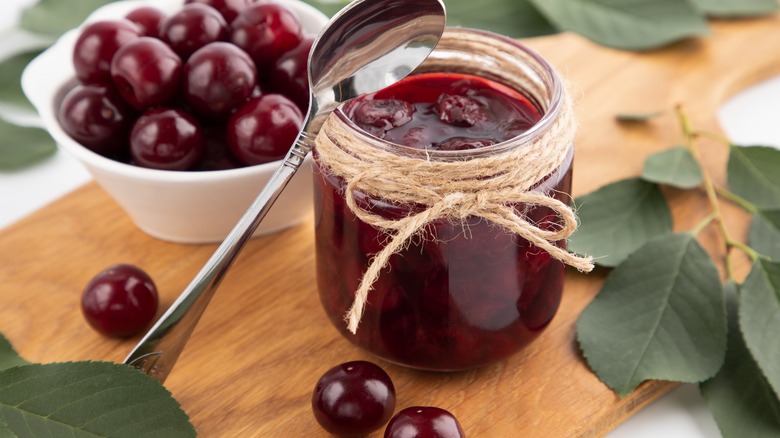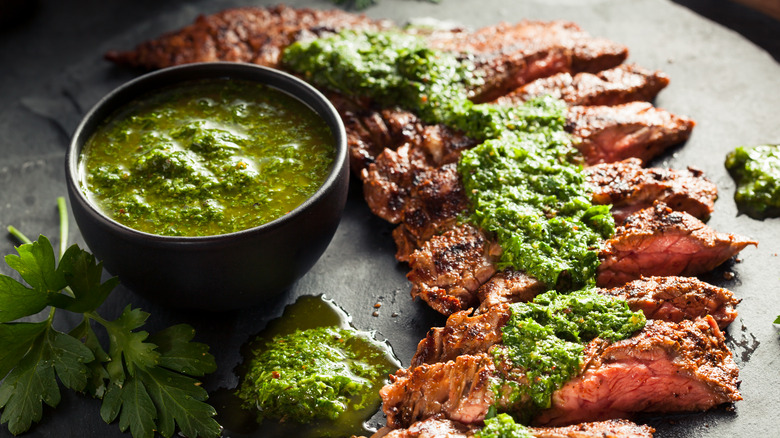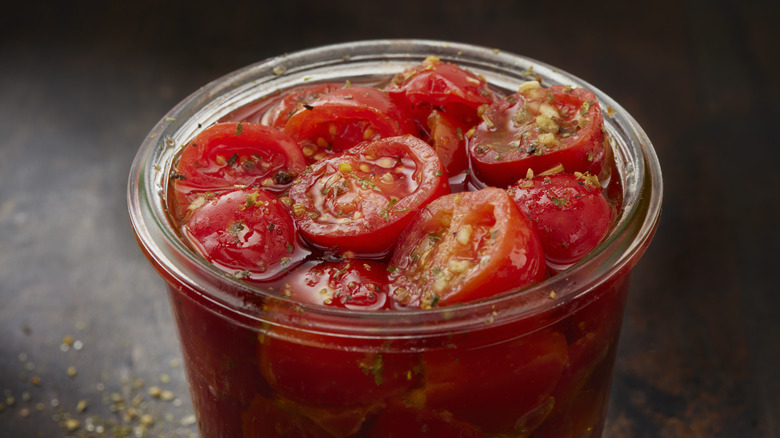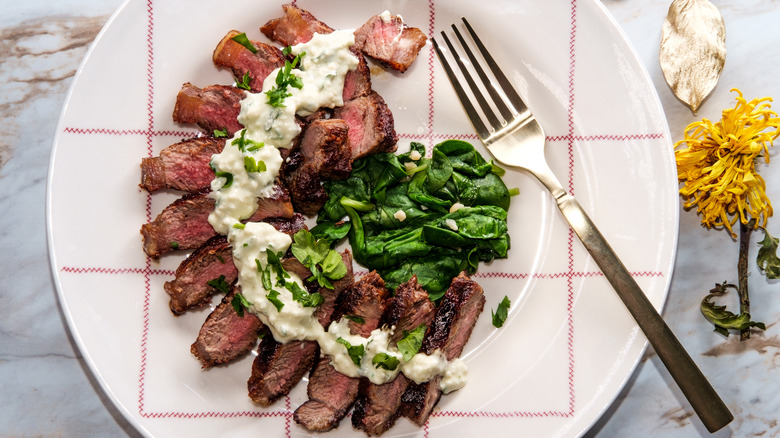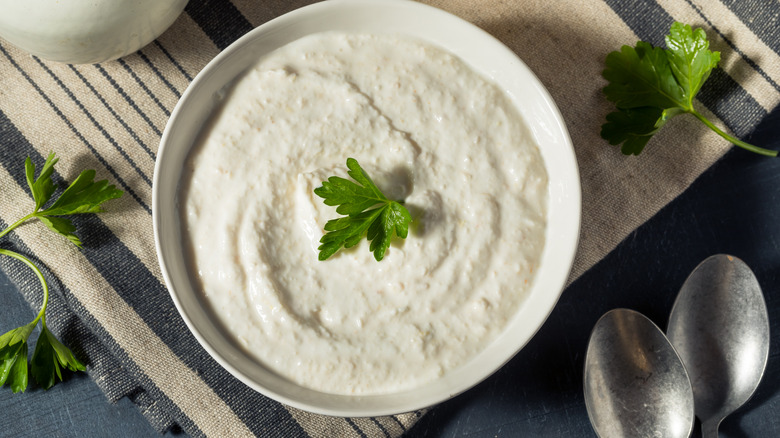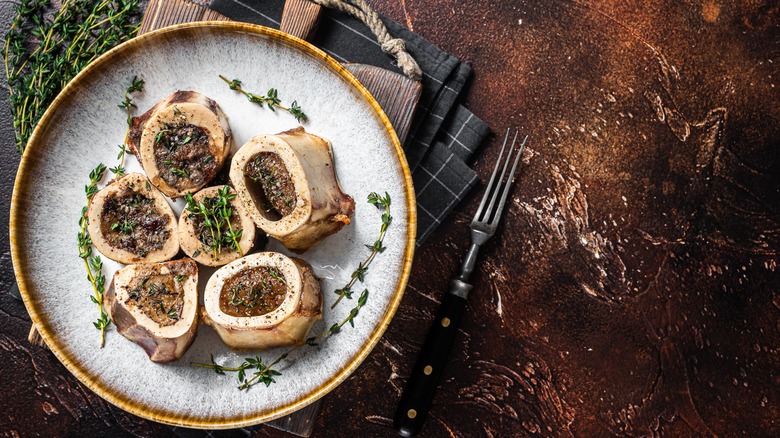12 Best Sauces To Serve With Steak
There are few meals as celebratory as a succulent, juicy steak. Grilled, seared, or broiled, a well-cooked (medium rare, of course, not well done) cut of beef should feature a golden brown crust and minimal work on behalf of your steak knife. Adding sauce is one of the simplest ways to elevate your next beefy meal to dinner party status.
Before you go reaching for that familiar bottle of A.1, consider whipping up your own beautifully balanced concoction. While A.1. Sauce certainly enjoyed pride of place at the table for decades, the classic steak sauce has become less popular in recent years. This is partially because the condiment actually served an entirely different purpose in its heyday. Prior to the establishment of Certified Angus Beef in 1978 and subsequent meat-producing standards, the quality of the steaks consumed around the world was significantly lower, so a sauce was needed to mask the flavor of inferior beef rather than enhance its meaty goodness.
Today, most meat eaters enjoy a wide selection of quality marbled meats even at the local grocery store — an upgrade that should be appropriately celebrated with a superior sauce. Ready to raise the stakes on your next beef dinner? Here are a few sidekick sauces to serve with steak.
Homemade A.1.
The secret to America's most recognizable steak sauce remains just that. Parent company Kraft Heinz keeps the recipe under wraps, but that hasn't stopped the masses from attempting to recreate A.1. steak sauce's delicious signature sour bite.
Armchair sleuths have deduced that a blend of sweet ingredients (corn syrup and raisins), savory elements (onions, garlic, and an array of unspecified spices), and a few tangy twists (orange, vinegar, and tomato) combine their mouthwatering powers to give A.1. its unique, all-encompassing flavor. Most copycat recipes use Worchester sauce to achieve a similar effect, a trick that can work wonders for a home cook on a budget.
You can attempt to recreate the secret sauce with a twist by adding Medjool dates rather than raisins into the mix. A blend of sherry and apple cider vinegar, optional tamarind paste, and a dash of Dijon mustard bring extra tang to the party, tempered by savory additions like tomato paste, shallots, and butter.
While classic steak sauce is certainly a nostalgic addition to any dinner party, remember that its overpowering flavor was created to cover up rather than enhance a cut of beef. So, if you're planning to splurge on meticulously marbled rib eyes or impressive Tomahawk steaks, maybe leave the A.1. off the table to let that beautifully beefy flavor shine.
Simple steakhouse mushroom sauce
Beef and mushrooms are a match made in steakhouse heaven, specifically for their satisfying umami flavor. But what exactly is umami? Sweet, sour, salty, and bitter are easily identifiable flavors, but the elusive "fifth taste" is a distinctly savory sensation found in specific ingredients like Parmesan cheese, miso paste, and mushrooms.
Packed with an amino acid called glutamate, umami-rich mushrooms enhance the savory flavors of steak without contributing additional fat, sodium, or cholesterol. Harness the full power of umami by transforming mushrooms and a few pantry staples into a luxurious steakhouse mushroom sauce. The light and tangy nature of the sauce makes it the perfect accompaniment to well-marbled cuts like ribeyes and New York strips.
Fabulous flavor can be achieved by pairing almost any type of mushroom with steak, but for depth of flavor and a meaty texture, crimini mushrooms — or "baby bellas" — just can't be beaten. Feel free to experiment with other types of funghi, including shiitakes, mature portobellos, white buttons, and even dried mushrooms, which can add an even richer umami flavor. Dry sherry, soy sauce, and rich beef broth round out the sumptuous sauce to create a perfectly balanced beef accouterment that even your in-laws will love.
Béarnaise sauce
Creamy, tangy, and downright delicious, béarnaise sauce is a steakhouse staple for a reason. The luscious steak topping is an indulgent addition to any cut of beef, specifically fattier cuts that benefit from vinegar's acidic tang and the brightness that comes from the addition of delicate shallots and tarragon.
Delicious as it is, there's a reason you rarely find béarnaise sauce beyond the oak-paneled doors of a classic steakhouse. An offshoot of traditional French hollandaise sauce, béarnaise can be notoriously tricky to make: Butter is slowly added to a white wine vinegar reduction seasoned with shallots, tarragon, and chervil to form an emulsion thickened with egg yolks, all traditionally done with skill and precision over a double-boiler. The finicky emulsion can break if the butter is added too fast, turn to scrambled eggs if it gets too hot, or result in a runny mess if it doesn't get hot enough.
Luckily, there is a method to the madness. It turns out the trick to a perfectly creamy and rich béarnaise sauce is a warm blender. By rinsing the inside of your blender with hot tap water (just be sure to wipe it dry), the butter stays soft, resulting in a smooth, luscious sauce rather than the chunky mess that can occur if the butter seizes up.
Green peppercorn sauce
For a simple sauce that delivers big on flavor, this green peppercorn variation ticks all the tasty boxes. A play on classic steak au poivre, the piquant sauce relies on the left-behind bits of browned beef in the pan (also known as fond) for richness, though a dash of heavy cream, a bit of butter, and a splash of Cognac never hurt.
While traditional steak au poivre relies on pungent black peppercorns for flavor, this sauce tames things down a bit by making use of much more mild green peppercorns. Typically stored in brine or vinegar, the underripe berry is light and tart rather than sharp and spicy like its dried counterpart. That sharpness helps to balance out the sauce's richness, resulting in a delightfully complex condiment for your next steak.
So why go through the trouble of making the sauce if you're not making Julia Child's steak au poivre? The version included in her 1961 "Mastering the Art of French Cooking" uses beef filet, a specific (and expensive) cut that found its way onto steakhouse menus everywhere once the book gained popularity. Green peppercorn sauce easily imbues those classic flavors into any cut of beef your meat-loving heart desires. Plus, it comes together in just 15 minutes.
Bordelaise
Elevating grilled steak to an impressive restaurant-quality meal doesn't have to be a daunting endeavor. Shallots and garlic, red wine, and a bit of butter go a long way in a twist on traditional French bordelaise, a delightful steak sauce that requires more patience than kitchen know-how.
The classic bordelaise recipe can be a lengthy and expensive affair, using luxurious ingredients like Bordeaux and bone marrow. However, modern adaptations eschew the pricy French wine for more easily accessible bottles like cabernet sauvignon, cabernet franc, merlot, or malbec — any quality, dry red wine will do. A good rule of thumb is to use a wine you would drink. Store-bought demi-glace or beef stock offers budget-friendly substitutions for traditional bone marrow.
The red wine with red meat rule is an often-repeated phrase by party planners and sommeliers alike, but it's not just a tradition that keeps this tried-and-true pairing alive. As it turns out, it's scientifically proven that fatty beef and dry red wine balance each other out in the best way. Tannin molecules naturally found in wine via the aging process help to break down the meat's fat which in turn helps to tone down red wine's bitterness and ramp up its fruit-forward flavors. In short, they bring out the best in each other. Cheers to that.
Herb caper sauce
Not every cut of steak needs to be doused in butter to enhance its flavor. A simple blend of fresh herbs, briny capers, and tart lemon juice brings brightness to grilled hanger steaks that will liven up that midweek dinner slump.
The acidity from the capers and lemon juice helps to cut through the char of grilled beef, especially leaner cuts like a flat iron or hanger steak that don't have the benefit of rich marbling. What's even better? This sauce comes together in less time than it takes to grill those super-thin steaks. If needed, you can prepare the ingredients the night before to save time and enjoy an even more flavorful sauce by letting those flavors mingle.
If you're crunched for time, you can even use this herb caper sauce as a reverse marinade. A tasty antidote to the last-minute dinner guest blues, reverse marinading does double duty by flavoring the freshly grilled steak while also allowing it to rest properly. Try marinating your meat after grilling by simply placing the cooked beef and the marinade in a shallow dish, flipping every few minutes to allow both sides to absorb all that herby flavor. Unlike pre-marinades, you can save the sauce to serve over the steak instead of having to throw it out. It's a culinary win-win.
Pump up the jam
If cranberry sauce can enhance the flavor of notoriously dry turkey, just imagine what jam can do for a rich and succulent steak. The unexpected condiment works wonders with red meat — especially varieties featuring dark fruits like blackberries and cherries — thanks to a blend of sweetness, acidity, and a touch of sourness that cuts through the richness of a well-marbled cut of meat like a ribeye or New York strip.
Rather than slathering your steak with a spoonful of jelly, try using it as a sauce starter. Throw your favorite dark fruit jam in a small saucepan with some minced garlic and onion, a splash of vinegar, and a selection of spices like black pepper, star anise, or ginger, depending on your preference. If you're looking for a little more direction, grilled tri-tip with blackberry mustard is a great place to start. The tang of the mustard and the sweetness of the blackberries blend beautifully into a luscious topping for an easy grilled tri-tip steak.
Still not convinced? Start small with more savory options like a burnt onion jam, tomatillo jam, or even a drizzle of high-quality balsamic vinegar. Made with slightly sweet produce, these tasting toppings provide the perfect balance of flavor for a freshly seared steak.
Chimichurri
Light and refreshing, chimichurri brings the perfect touch of brightness to lightly charred grilled steaks. The Argentinian sauce can be served with any type of meat dish but pairs particularly well with the smoky flavor of beef. While there are slight variations, the basic recipe typically includes chopped parsley, garlic, oregano, and red or white wine vinegar. The combination of fresh green herbs and acid helps to cut through the richness of steak, making chimichurri the perfect accompaniment to your next backyard barbecue.
Chimichurri is widely believed to have its origins in Argentinan and Uruguan gaucho culture, but how it came by its distinctive name is a bit more of a mystery. One of the most famous legends involves an Irish immigrant named Jimmy and his famous curry. "Jimmy's curry" morphed into chimichurri. However, this version, while fun, is likely a myth. More likely candidates include mistranslated English requests from captured British soldiers, Basque immigrant influences, and an indigenous Quechua word for a strong sauce to accompany meats.
No matter its origins, chimichurri sauce fans are grateful for its flavorful existence. And home cooks can rejoice at how simple it is to prepare, especially with the help of a food processor. When blending your fresh ingredients, just be sure to keep your finger on the pulse button — the sauce should be chopped, not pureed.
Tomato Vinaigrette
Mix up your weeknight dinner routine by topping a quick-cooking cut of beef like flank, top sirloin, or skirt steak with a simple tomato vinaigrette. A handful of fresh summer ingredients and a mason jar are all you need to whip up a flavorful sauce that does double-duty as a salad dressing.
The olive oil-based vinaigrette helps to moisten leaner cuts of beef, while acidic ingredients like fresh tomatoes and a splash of sherry vinegar cut through the smoky richness of the meat. Aromatics like fresh herbs and delicate shallots elevate the beefy flavors of cheap steaks from boring to mouthwatering. When tomatoes are in season during the summer, search for heirloom varieties to achieve a truly mouthwatering flavor, though a combination of cherry and grape tomatoes will work perfectly well during the cooler months.
While it's not advised to make tomato vinaigrette in advance to avoid loss of flavor, it's not a time-consuming endeavor. In fact, the simple sauce can be shaken up while your steak is sizzling away on the stove or grill. Just layer the sliced tomatoes, garlic, shallot, and fresh herbs in a pint-sized mason jar, add sherry vinegar and olive oil, a dash of salt and pepper, and shake well. Use the mixing vessel as a serving container to cut down on dishes — just say it goes with your farmhouse-chic aesthetic.
Blue cheese sauce
As polarizing as it is pungent, blue cheese pairs particularly well with beef. Steakhouses have been serving indulgent Roquefort sauces alongside perfectly seared steaks for decades; not that everyone is a fan of the combination.
Before turning your nose up at the creamy condiment, consider the flavor profiles of beef and blue cheese. Rich, smoky meats benefit from the sharpness blue cheese brings to the table, a piquant pairing that cuts through the fattiness of a well-marbled steak. The creamy texture of the aged dairy creates a nice contrast as well since even the most tender cuts of beef require a bit of chew. Different in every way, the beef-and-blue-cheese pairing is just delicious proof that opposites attract.
When making a blue cheese-based sauce to pair with your steak, it's important to consider the type of dairy you'll use. Traditional options like French Roquefort and English Stilton are classics, but those who are unsure about the strength of the cheese they choose should go with Gorgonzola. Creamier and milder than other types of blue cheese, the easily sourced Italian variety works particularly well in sauces. Melted into heavy cream with a dash of Worcestershire sauce, blue cheese sauce is a simple solution to the bland steak blues.
Horseradish sauce
Spicy, tangy horseradish has long been a favorite of roast beef lovers everywhere, and for good reason. The sharp flavors of the root cut through the meaty richness of large cuts of beef like prime rib or beef filet, so it stands to reason that the potent condiment would also work wonders on thick, juicy steaks.
Horseradish certainly has a strong bite, but its potency dissipates much more quickly than other foods humans identify as "spicy." Both horseradish and chili peppers alert the same nasal and oral sensory receptors, but they release their heat differently. Capsaicin oil found in chili peppers lingers, creating the heat build-up typically associated with spicy foods, while a compound called allyl isothiocyanate is responsible for horseradish's heat. The volatile nature of allyl isothiocyanate means that its peppery flavor fizzles out quickly, resulting in a hit of spice that subsides in minutes. Less heat means that horseradish provides a happy medium for those looking for a little kick without blowing their tastebuds away.
The best way to harness horseradish's power for the good of your next steak is through an elevated mayonnaise. Toss in about a tablespoon of horseradish for every 3 to 4 tablespoons of mayo, plus a squeeze of lemon juice and a dash of black pepper for one of the simplest sauces out there. Just keep in mind that if you choose to grind your horseradish fresh, you'll want to use the sauce immediately to avoid losing out on flavor.
Bone marrow butter
There are few easier ways to impart mouthwatering flavor on a piece of meat than with flavored butter. Nutrient-dense and luxuriously rich, bone marrow butter is a surprisingly affordable way to elevate your steaks to meaty new heights.
Due to the rising popularity of bone marrow, beef shank or femur bones are fairly easy to find at the grocery store, though sourcing them from a local butcher is even better. Once you've obtained the bones, you'll need to roast them, which might just be the easiest thing you've ever done in the kitchen. Simply place the bones in an ungreased roasting pan, stick them in an oven at 450 degrees Fahrenheit for about 30 minutes, and sprinkle with salt and pepper once done. That's it.
The resulting marrow will be the consistency of softened butter, making it super easy to scoop from the bones (once cooled, of course). Combine the cooled marrow with softened butter, lemon zest, salt and pepper, and any additional herbs or spices that suit your palate (roasted garlic would work beautifully here). While not technically a sauce, rich and nutty bone marrow butter slathered over a freshly grilled steak as it rests is an indulgent treat even the most discerning in-laws couldn't turn down — not that they need to know how easy it is to make.
